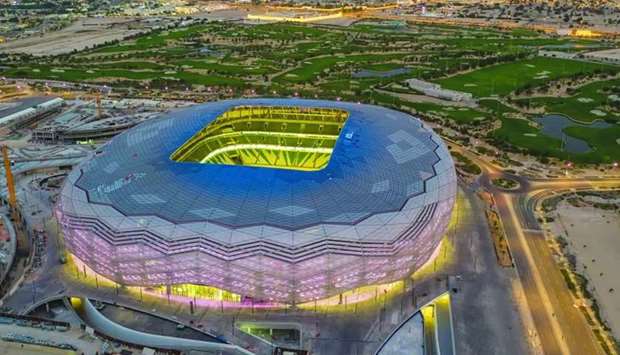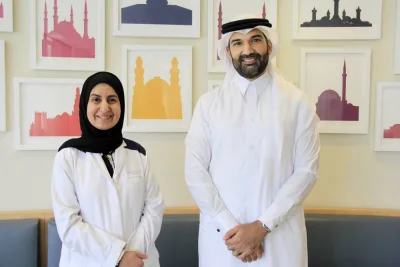Sustainability is at the heart of preparations for the FIFA World Cup 2022, with Qatar on course to deliver the first carbon-neutral event in tournament history.
The Supreme Committee for Delivery & Legacy (SC) has listed ten ways in which Qatar is reducing its carbon footprint in the lead-up to the first FIFA World Cup in the Middle East and Arab world.
1. Compact tournament
Qatar 2022 will be the most compact FIFA World Cup in modern history.
All eight stadiums are close together, with the longest distance between venues just 75km (Al Bayt Stadium in Al Khor to Al Janoub Stadium in Al Wakra).
Fans and players will stay in one accommodation and train at the same location throughout the tournament.

Al Bayt Stadium has achieved a five-star GSAS rating
2. No internal flights
Fans, players and officials will not need to take any domestic flights once they arrive in Qatar.
Thanks to the compact nature of the event, they will never be far from a stadium, training site or tourist attraction.
This is in stark contrast to previous tournaments, where fans and players often flew thousands of miles between matches.
3. Global Sustainability Assessment System (GSAS) certification
Every Qatar 2022 tournament venue will achieve GSAS certification.
A venue’s level of sustainability is certified according to various categories, including design, construction, energy and water usage.
Every stadium is on track to receive a minimum four-star GSAS rating for the design, build and construction.
Education City Stadium and Al Bayt Stadium have both achieved five-star ratings.
4. First fully dismountable FIFA World Cup stadium
Constructed from shipping containers and removable seats, the stunning Ras Abu Aboud Stadium will provide an innovative blueprint for major tournament hosts in future.
The 40,000-capacity venue is the first fully-dismountable FIFA World Cup stadium in tournament history.
It will be completely dismantled and repurposed after the event, with its parts used to create sporting facilities in Qatar and overseas.
The shipping containers used to build the stadium were originally used to transport materials to Qatar for the construction.

Ras Abu Aboud Stadium will provide an innovative blueprint for major tournament hosts in future
5. Recycling at stadiums
To limit the carbon footprint, all Qatar 2022 projects implemented measures to organise waste segregation and management during the construction phase.
Stadium sites diverted solid waste through recycling.
For instance, the majority of waste generated at Al Janoub Stadium (90%) and Ahmad Bin Ali Stadium (84%) was recycled during construction.
Recycling systems will also be in place during match days.
6. Sustainable sourcing
Qatar’s organising body, the SC, in collaboration with FIFA and the FIFA World Cup Qatar 2022 LLC, has established a Sustainable Sourcing Code setting out minimum standards and benchmarks for suppliers and sponsors of the tournament.
Put simply, all suppliers must meet strict environmental criteria.

The Doha Metro will be responsible for transporting thousands of fans around the country during Qatar 2022
7. State-of-the-art public transport
The Doha Metro will be responsible for transporting thousands of fans around the country during Qatar 2022.
The electric Metro system uses regenerative braking systems, which help reduce its carbon footprint.
In addition, its stations carry various “green” credentials and operate under “green” building certification.
Qatar’s “green” transportation plans also extend to electric cars and buses.
In collaboration with the Qatar General Electricity and Water Corporation (Kahramaa), charging stations for electric cars are being installed at various convenient locations around the country.
Electric scooters and bicycles are also available in outdoor locations, including parks and the Doha Corniche.
Meanwhile, a fleet of electric buses will be used to transport fans between their accommodation and tournament venues in 2022.
8. Major programme for ‘green’ accommodation in Qatar
Delivering sustainable hospitality solutions is at the core of the tournament.
An important component of the tournament’s fan experience is accommodation.
Through partnering with Qatar Green Building Council, this edition of the FIFA World Cup will promote “green” practices in the hotel sector by reducing the sector’s environmental impact and capitalising on efficient and responsible hotel operations.
9. Tree planting and ‘greening; the country
As part of the tournament’s “green” legacy, tree planting constituted a major aspect of stadium design and planning.
With native trees and plants in stadium parklands and precincts, a campaign to “green” the country is an opportunity to significantly reduce carbon emissions and leave behind a “green” legacy for future generations.
10. Al Kharsa'ah 800MW solar power plant
Finally, the Al Kharsa’ah solar power plant will reduce the country’s overall carbon footprint.
Located 80km west of Doha, the 800MW solar energy plant will reduce carbon dioxide (*CO2) emissions while limiting Qatar’s reliance on gas for power generation.



